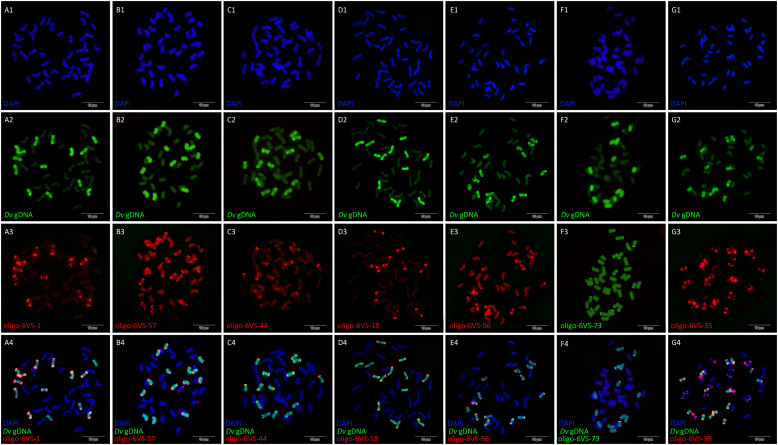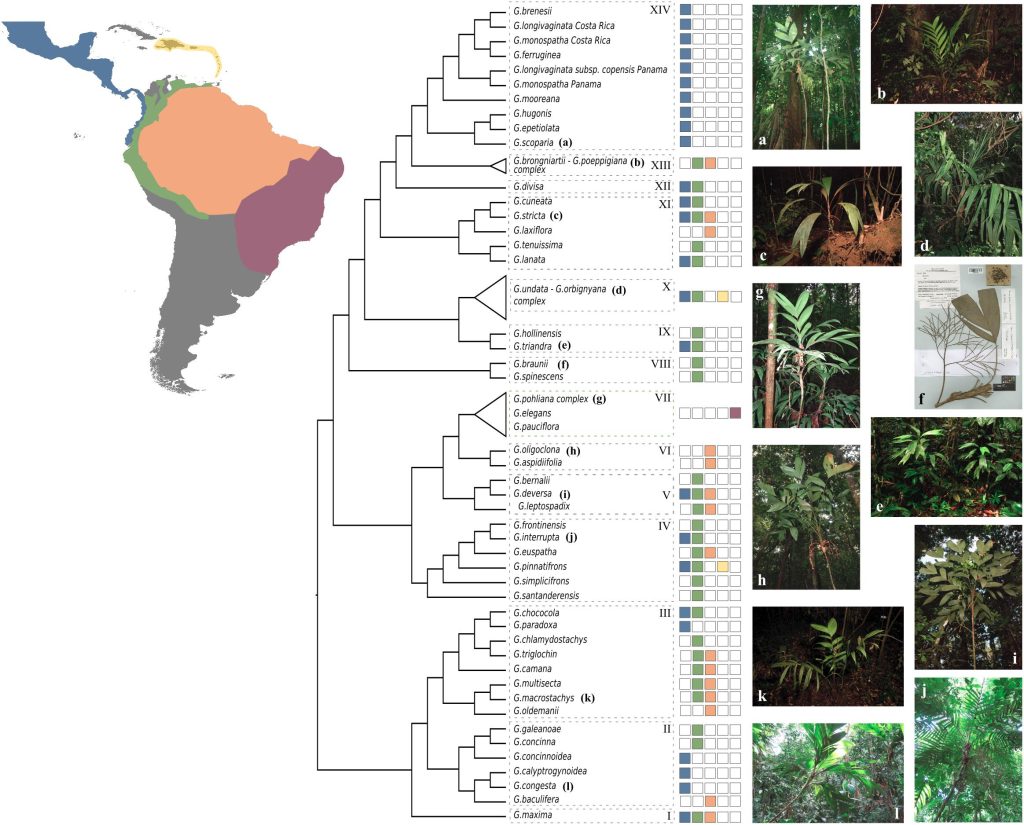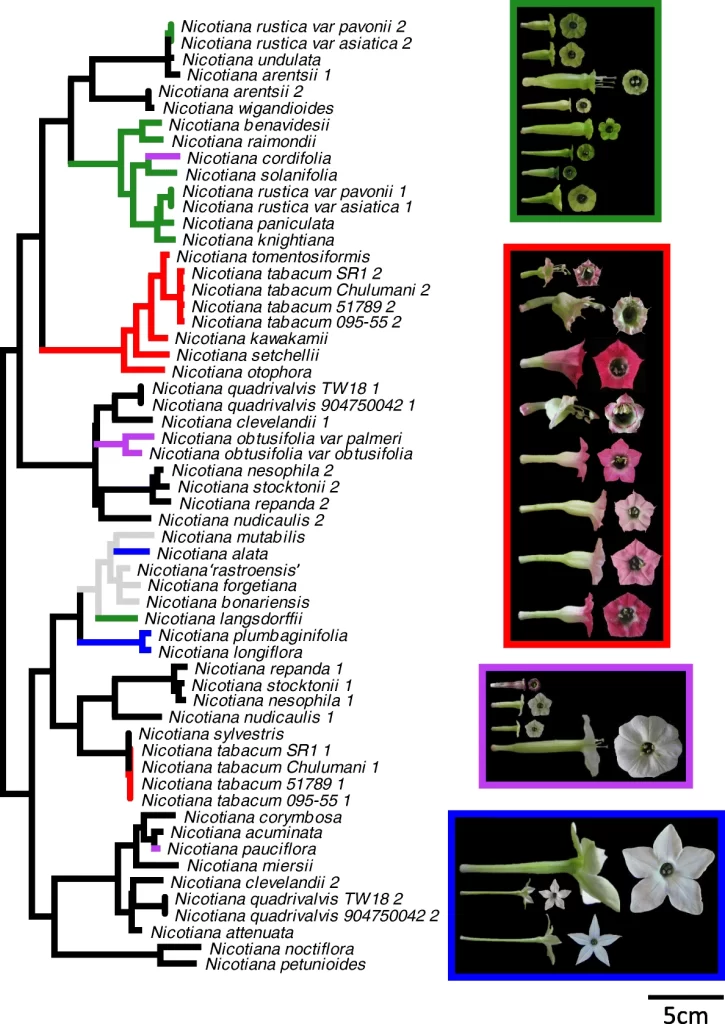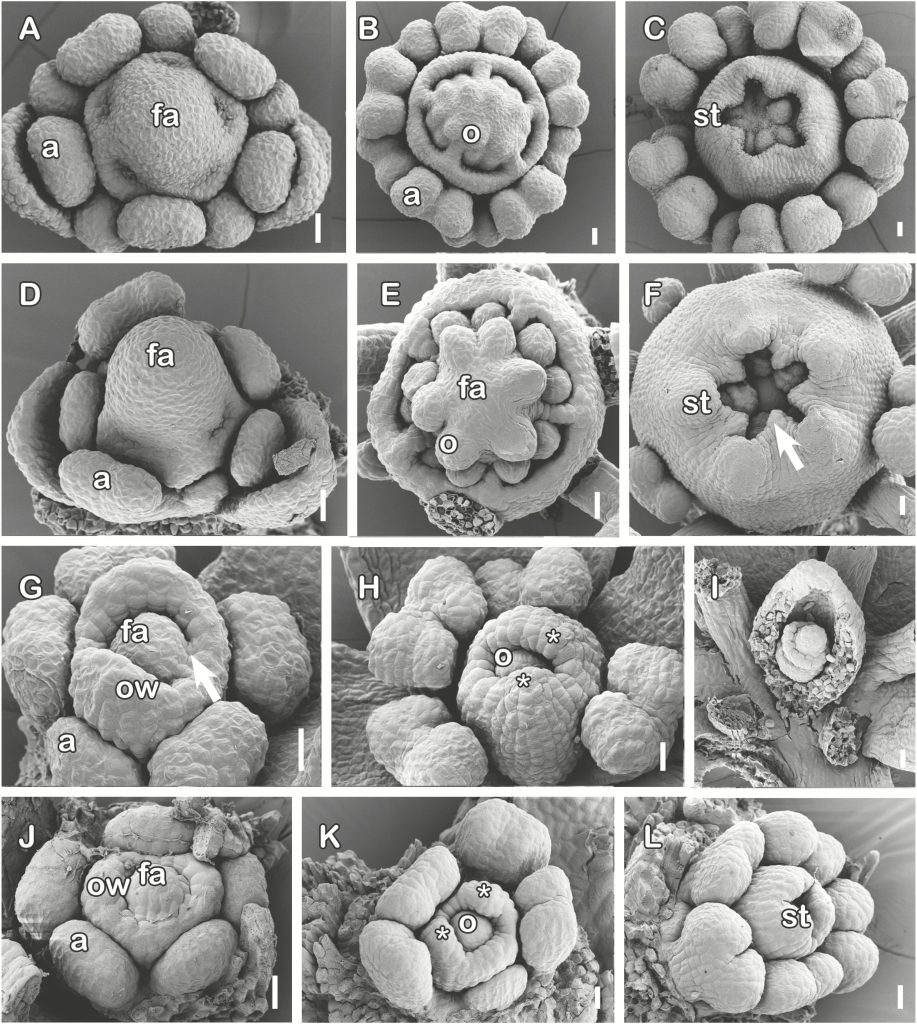2025
- (2025) Mišina, I., Lazdiņa, D. & Górnaś, P. Tocochromanols in the Leaves of Plants in the Hypericum and Clusia Genera. Molecules (Basel, Switzerland), 30, 709. https://doi.org/10.3390/molecules30030709
- (2025) Murrell, O. Using pedigree tracking of the ex situ metacollection of Amorphophallus titanum (Araceae) to identify challenges to maintaining genetic diversity in the botanical community. Annals of Botany, 1–8. https://doi.org/10.1093/aob/mcaf038
- (2025) Woudstra, Y., Rees, P., Rakotoarisoa, S.E., Klopper, R.R., Smith, G.F., Rønsted, N. & Grace, O.M. Nuclear phylogenomics reveals strong geographic patterns in the evolutionary history of <em>Aloe</em> and related genera (alooids). bioRxiv, 2025.02.28.640761. https://doi.org/10.1101/2025.02.28.640761
2024
- (2024) Ang, A.C.H., Mutte, S., Weijers, D. & Østergaard, L. ETTIN-mediated auxin signalling is an angiosperm-specific neofunctionalization for carpel development. bioRxiv, 2024.09.02.610784. https://doi.org/10.1101/2024.09.02.610784
- (2024) Carruthers, T., Moerland, M.S., Ebersbach, J., Favre, A., Folk, R.A., Hawkins, J.A., Muellner-Riehl, A.N., Röser, M., Soltis, D.E., Tkach, N., Baker, W.J., de Vos, J.M. & Eiserhardt, W.L. Repeated upslope biome shifts in Saxifraga during late-Cenozoic climate cooling. Nature Communications, 15, 1100. https://doi.org/10.1038/s41467-024-45289-w
- (2024) de Vos, J.M., Woudstra, Y., Leitch, I.J. & Hidalgo, O. Assessing male reproductive investment in Papaveraceae using flow cytometry reveals lineage-specific trajectories to pollen-to-ovule ratio reduction. bioRxiv, 2024.08.23.609364. https://doi.org/10.1101/2024.08.23.609364
- (2024) Fraiture, M.-A. Development and validation of a ddPCR assay to detect and quantify tobacco DNA in smoke and smokeless tobacco and tobacco-free products. Heliyon, 10. https://doi.org/10.1016/j.heliyon.2024.e32964
- (2024) Lyczakowski, J.J. & Wightman, R. Convergent and adaptive evolution drove change of secondary cell wall ultrastructure in extant lineages of seed plants. New Phytologist, 243, 2061–2065. https://doi.org/10.1111/nph.19983
- (2024) Namusoke, E. African Collections Futures, University of Cambridge.
- (2024) Rhizopoulou, S. & Pouris, J. Retrospective Approach to the Endemic Dianthus fruticosus L. ssp. fruticosus on Serifos Island (Cyclades, Greece). Plants (Basel, Switzerland), 13, 3002. https://doi.org/10.3390/plants13213002
- (2024) Woudstra, Y., Rees, P., Rakotoarisoa, S.E., Rønsted, N., Howard, C. & Grace, O.M. An updated DNA barcoding tool for <em>Aloe vera</em> and related CITES-regulated species. bioRxiv, 2024.07.09.602761. https://doi.org/10.1101/2024.07.09.602761
- (2024) Yu, L., Wilson, L.F.L., Terrett, O.M., Wurman-Rodrich, J., Łyczakowski, J.J., Yu, X., Krogh, K.B.R.M. & Dupree, P. Evolution of glucuronoxylan side chain variability in vascular plants and the compensatory adaptations of cell wall–degrading hydrolases. New Phytologist, 244, 1024–1040. https://doi.org/10.1111/nph.19957
2023
- (2023) Fricker, R.A., Anderson, J., Anderton, C., Cheng, E., Choi, H., Miao, S., Wenban-Smith, E. & Clark, N. Establishing a Phenology Research Project at Cambridge University Botanic Garden. Nature in Cambridgeshire, 64.
- (2023) Jacquemyn, H., Pankhurst, T., Jones, P.S., Brys, R. & Hutchings, M.J. Biological Flora of Britain and Ireland: Liparis loeselii. Journal of Ecology, 111, 943–966. https://doi.org/10.1111/1365-2745.14086
- (2023) Tryfona, T., Bourdon, M., Delgado Marques, R., Busse-Wicher, M., Vilaplana, F., Stott, K. & Dupree, P. Grass xylan structural variation suggests functional specialization and distinctive interaction with cellulose and lignin. The Plant Journal, 113, 1004–1020. https://doi.org/10.1111/tpj.16096
- (2023) Wilson, L.F.L., Neun, S., Yu, L., Tryfona, T., Stott, K., Hollfelder, F. & Dupree, P. The biosynthesis, degradation, and function of cell wall β-xylosylated xyloglucan mirrors that of arabinoxyloglucan. New Phytologist, 240, 2353–2371. https://doi.org/10.1111/nph.19305
2022
- (2022) Brook, T.S., Coates, E., Orchard, L., Leggett, H. & Helm, C.V. Winter bat activity at Cambridge University Botanic Garden. Nature in Cambridgeshire.
- (2022) Debray, K., Le Paslier, M.-C., Bérard, A., Thouroude, T., Michel, G., Marie-Magdelaine, J., Bruneau, A., Foucher, F. & Malécot, V. Unveiling the Patterns of Reticulated Evolutionary Processes with Phylogenomics: Hybridization and Polyploidy in the Genus Rosa. Systematic Biology, 71, 547–569. https://doi.org/10.1093/sysbio/syab064
- (2022) Preston, C.D. The bryophytes of Cambridge University Botanic Garden resurveyed, 2021–22. Nature in Cambridgeshire.
2021
- (2021) Melelli, A., Pantaloni, D., Balnois, E., Arnould, O., Jamme, F., Baley, C., Beaugrand, J., Shah, D.U. & Bourmaud, A. Investigations by AFM of Ageing Mechanisms in PLA-Flax Fibre Composites during Garden Composting. Polymers, 13, 2225. https://doi.org/10.3390/polym13142225
2020
- (2020) Ives, J. Biological controls in botanic gardens. Sibbaldia: the International Journal of Botanic Garden Horticulture, 117–125. https://doi.org/10.24823/Sibbaldia.2020.292
- (2020) Lei, J., Zhou, J., Sun, H., Wan, W., Xiao, J., Yuan, C., Karafiátová, M., Doležel, J., Wang, H. & Wang, X. Development of oligonucleotide probes for FISH karyotyping in Haynaldia villosa, a wild relative of common wheat. The Crop Journal, 8, 676–681. https://doi.org/10.1016/j.cj.2020.02.008
- (2020) Pantaloni, D., Shah, D., Baley, C. & Bourmaud, A. Monitoring of mechanical performances of flax non-woven biocomposites during a home compost degradation. Polymer Degradation and Stability, 177, 109166. https://doi.org/10.1016/j.polymdegradstab.2020.109166
- (2020) Rumsey, F. & Stroh, P. Will de-extinction be forever? Lessons from the re-introductions of Bromus interruptus (Hack.) Druce. Journal for Nature Conservation, 56, 125835. https://doi.org/10.1016/j.jnc.2020.125835
- (2020) Sinnott-Armstrong, M.A., Lee, C., Clement, W.L. & Donoghue, M.J. Fruit syndromes in Viburnum: correlated evolution of color, nutritional content, and morphology in bird-dispersed fleshy fruits. BMC Evolutionary Biology, 20, 7. https://doi.org/10.1186/s12862-019-1546-5
- (2020) Song, X., Song, R., Zhou, J., Yan, W., Zhang, T., Sun, H., Xiao, J., Wu, Y., Xi, M., Lou, Q., Wang, H. & Wang, X. Development and application of oligonucleotide-based chromosome painting for chromosome 4D of Triticum aestivum L. Chromosome Research, 28, 171–182. https://doi.org/10.1007/s10577-020-09627-0
2019
- (2019) Craene, L.P.R.D. & Wei, L. Floral development and anatomy of Macarthuria australis (Macarthuriaceae): key to understanding the unusual initiation sequence of Caryophyllales. Australian Systematic Botany, 32, 49–60. https://doi.org/10.1071/SB18069
- (2019) Loiseau, O., Olivares, I., Paris, M., de La Harpe, M., Weigand, A., Koubínová, D., Rolland, J., Bacon, C.D., Balslev, H., Borchsenius, F., Cano, A., Couvreur, T.L.P., Delnatte, C., Fardin, F., Gayot, M., Mejía, F., Mota-Machado, T., Perret, M., Roncal, J., Sanin, M.J., Stauffer, F., Lexer, C., Kessler, M. & Salamin, N. Targeted Capture of Hundreds of Nuclear Genes Unravels Phylogenetic Relationships of the Diverse Neotropical Palm Tribe Geonomateae. Frontiers in Plant Science, 10. https://doi.org/10.3389/fpls.2019.00864
- (2019) Lyczakowski, J.J., Bourdon, M., Terrett, O.M., Helariutta, Y., Wightman, R. & Dupree, P. Structural Imaging of Native Cryo-Preserved Secondary Cell Walls Reveals the Presence of Macrofibrils and Their Formation Requires Normal Cellulose, Lignin and Xylan Biosynthesis. Frontiers in Plant Science, 10. https://doi.org/10.3389/fpls.2019.01398
- (2019) McCarthy, E.W., Landis, J.B., Kurti, A., Lawhorn, A.J., Chase, M.W., Knapp, S., Le Comber, S.C., Leitch, A.R. & Litt, A. Early consequences of allopolyploidy alter floral evolution in Nicotiana (Solanaceae). BMC Plant Biology, 19, 162. https://doi.org/10.1186/s12870-019-1771-5
2018
- (2018) Gross, M. Can botanic gardens save all plants? Current Biology, 28, R1075–R1078. https://doi.org/10.1016/j.cub.2018.09.010
- (2018) Males, J. & Griffiths, H. Economic and hydraulic divergences underpin ecological differentiation in the Bromeliaceae. Plant, Cell & Environment, 41, 64–78. https://doi.org/10.1071/FP17071
- (2018) Males, J. Concerted anatomical change associated with crassulacean acid metabolism in the Bromeliaceae. Functional Plant Biology, 45, 681–695. https://doi.org/10.1111/pce.12954
- (2018) Ridley, C.J.A., Parker, B.M., Norman, L., Schlarb-Ridley, B., Dennis, R., Jamieson, A.E., Clark, D., Skill, S.C., Smith, A.G. & Davey, M.P. Growth of microalgae using nitrate-rich brine wash from the water industry. Algal Research, 33, 91–98. https://doi.org/10.1016/j.algal.2018.04.018
2017
- (2017) Borgia, V., Carlin, M.G. & Crezzini, J. Poison, plants and Palaeolithic hunters. An analytical method to investigate the presence of plant poison on archaeological artefacts. Quaternary International, 427, 94–103. https://doi.org/10.1016/j.quaint.2015.12.025
- (2017) Busà, C., Rickard, J.J.S., Chun, E., Chong, Y., Navaratnam, V. & Oppenheimer, P.G. Tunable superapolar Lotus-to-Rose hierarchical nanosurfaces via vertical carbon nanotubes driven electrohydrodynamic lithography. Nanoscale, 9, 1625–1636. https://doi.org/10.1039/C6NR08706J
- (2017) Males, J. & Griffiths, H. Functional types in the Bromeliaceae: relationships with drought-resistance traits and bioclimatic distributions. Functional Ecology, 31, 1868–1880. https://doi.org/10.1007/s00442-017-3956-7
- (2017) Males, J. & Griffiths, H. Specialized stomatal humidity responses underpin ecological diversity in C3 bromeliads. Plant, Cell & Environment, 40, 2931–2945. https://doi.org/10.1111/btp.12475
- (2017) Males, J. Adaptive variation in vein placement underpins diversity in a major Neotropical plant radiation. Oecologia, 185, 375–386. https://doi.org/10.1111/pce.13024
- (2017) Males, J. Hydraulics link leaf shape and environmental niche in terrestrial bromeliads. Biotropica, 49, 891–902. https://doi.org/10.1111/1365-2435.12900
- (2017) Schimpf, N.G., Terblanche, J.S., Smit, M.F. & Matthews, P.G.D. Respiration, thermogenesis, and thermoregulation of Victoria cruziana flowers. Aquatic Botany, 138, 37–44. https://doi.org/10.1016/j.aquabot.2016.11.014
- (2017) Stroh, P. & Scott, W. Angelica archangelica subsp. littoralis (Apiaceae) – a new native taxon for Britain. New Journal of Botany, 7, 57–58. https://doi.org/10.1080/20423489.2017.1297353
- (2017) Stroh, P.A., Pescott, O.L. & Mountford, J.O. Long-term changes in lowland calcareous grassland plots using Tephroseris integrifolia subsp. integrifolia as an indicator species. Plant Ecology, 218, 1269–1281. https://doi.org/10.1007/s11258-017-0767-1
- (2017) York, J.E. & Davies, N.B. Female cuckoo calls misdirect host defences towards the wrong enemy. Nature Ecology & Evolution, 1, 1520–1525. https://doi.org/10.1038/s41559-017-0279-3
2016
- (2016) Busse-Wicher, M., Li, A., Silveira, R.L., Pereira, C.S., Tryfona, T., Gomes, T.C.F., Skaf, M.S. & Dupree, P. Evolution of Xylan Substitution Patterns in Gymnosperms and Angiosperms: Implications for Xylan Interaction with Cellulose. Plant Physiology, 171, 2418–2431. https://doi.org/10.1104/pp.16.00539
- (2016) Colchester, C. & Harrison, N.M. Personality in Blue Tits (Cyanistes caeruleus) and its Effect on Their Breeding Success. Ethology, 122, 695–701. https://doi.org/10.1111/eth.12516
- (2016) Figueiredo, E., Smith, G.F. & Crouch, N.R. The taxonomy and type of Kalanchoe sexangularis N.E.Br. (Crassulaceae). Bradleya, 2016, 92–96. https://doi.org/10.25223/brad.n34.2016.a24
2015
- (2015) Collett, C., Ardron, A., Bauer, U., Chapman, G., Chaudan, E., Hallmark, B., Pratt, L., Torres-Perez, M.D. & Wilson, D.I. A portable extensional rheometer for measuring the viscoelasticity of pitcher plant and other sticky liquids in the field. Plant Methods, 11, 16. https://doi.org/10.1186/s13007-015-0059-5
- (2015) López-Merino, L., Leroy, S.A.G., Haldorsen, S., Heun, M. & Reynolds, A. Can Triticum urartu (Poaceae) be identified by pollen analysis? Implications for detecting the ancestor of the extinct two-grained einkorn-like wheat. Botanical Journal of the Linnean Society, 177, 278–289. https://doi.org/10.1111/boj.12238
- (2015) Williams, S.J., Jones, J.P.G., Gibbons, J.M. & Clubbe, C. Botanic gardens can positively influence visitors’ environmental attitudes. Biodiversity and Conservation, 24, 1609–1620. https://doi.org/10.1007/s10531-015-0879-7
2012
- (2012) Bauer, U., Clemente, C.J., Renner, T. & Federle, W. Form follows function: morphological diversification and alternative trapping strategies in carnivorous Nepenthes pitcher plants. Journal of Evolutionary Biology, 25, 90–102. https://doi.org/10.1111/j.1420-9101.2011.02406.x
- (2012) Motuzaite-Matuzeviciute, G., Hunt, H.V. & Jones, M.K. Experimental approaches to understanding variation in grain size in Panicum miliaceum (broomcorn millet) and its relevance for interpreting archaeobotanical assemblages. Vegetation History and Archaeobotany, 21, 69–77. https://doi.org/10.1007/s00334-011-0322-2
- (2012) Thornham, D.G., Smith, J.M., Ulmar Grafe, T. & Federle, W. Setting the trap: cleaning behaviour of Camponotus schmitzi ants increases long-term capture efficiency of their pitcher plant host, Nepenthes bicalcarata. Functional Ecology, 26, 11–19. https://doi.org/10.1111/j.1365-2435.2011.01937.x
2011
- (2011) Bauer, U., Grafe, T.U. & Federle, W. Evidence for alternative trapping strategies in two forms of the pitcher plant, Nepenthes rafflesiana. Journal of Experimental Botany, 62, 3683–3692. https://doi.org/10.1093/jxb/err082
- (2011) Hunt, H.V., Campana, M.G., Lawes, M.C., Park, Y.-J., Bower, M.A., Howe, C.J. & Jones, M.K. Genetic diversity and phylogeography of broomcorn millet (Panicum miliaceum L.) across Eurasia. Molecular Ecology, 20, 4756–4771. https://doi.org/10.1111/j.1365-294X.2011.05318.x
2010
- (2010) Hunt, H.V., Denyer, K., Packman, L.C., Jones, M.K. & Howe, C.J. Molecular Basis of the Waxy Endosperm Starch Phenotype in Broomcorn Millet (Panicum miliaceum L.). Molecular Biology and Evolution, 27, 1478–1494. https://doi.org/10.1093/molbev/msq040
- (2010) Kromdijk, J., Griffiths, H. & Schepers, H.E. Can the progressive increase of C4 bundle sheath leakiness at low PFD be explained by incomplete suppression of photorespiration? Plant, Cell & Environment, 33, 1935–1948. https://doi.org/10.1111/j.1365-3040.2010.02196.x





